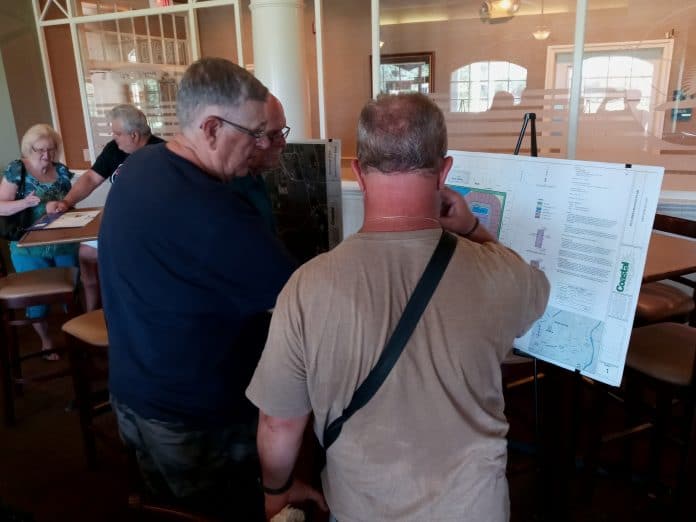Calling the hostile reception “fairly normal,” developers unveiled their plans to place 153 homes on a parcel of land with reported sinkholes before a crowd of unhappy local residents on Aug. 23.
The presentation took place at the Silverthorn Country Club in front of about 60 homeowners, many of whom are members of the Rainbow Woods Homeowners Association, an area that borders the proposed site. Lennar Homes was represented by Parker Hirons, vice president of the company’s Tampa division, along with company Land Development Director Jim Deitch and attorney Clark Hobby. The builder was also represented by Senior Vice President Don Lacey of Coastal Engineering Associates of Brooksville, the firm handling various engineering aspects of the project.
The meeting was held so the developer could discuss their proposal with residents and get feedback from the public on the project slated to begin next year, which has been named Rainbow Glen. Public hearings are slated for Oct. 11 before the Hernando County Planning and Zoning Board and Nov. 9 with the county commissioners to consider Lennar’s request to rezone the tract from R-1C residential zoning to planned development project-single family homes (PDP-SF).
Lennar wants to build 153 homes on a 40.5 tract just east of Frank W. Springstead High School, with a recreation area planned in the middle of the new neighborhood. The parcel is bordered on the north by Conway Street, on the south by Linden Drive, on the east by Lema Drive, and on the west by Augustine Road. The plan also calls for four drainage areas sprinkled across the tract, a recreation area in the center of the neighborhood, and a small park
on the southern border of the tract.
Contradicting rumors that the homes would be for low-income buyers, Hirons said the sales price would start at a minimum of $250,000 and go up from there. An informal survey of homes for sale in the surrounding neighborhood shows single-family units selling for an average of $250,000 to $375,000.
Residents focused much of their opposition on several key issues: The density plan called for too many single-family homes, the sinkhole issue could damage both new properties and established lots nearby, surrounding roads can’t handle the additional traffic load that would result, and two access points is not enough.
“We know development is going to happen, but it should only be in a way that the community can handle it, the schools, the roads, and infrastructure,” homeowner Andy Caamano said. “Instead, it appears this plan is only for making money, because they’re cramming too many units into an area with two accesses.”
Noting they’ve been building homes since 1954, Hirons said his company has learned a great deal about doing so in areas of Florida where sinkholes are common. He promised his company would be accountable in the future: “If any homeowners can prove by law that their property is damaged by sinkholes created by Lennar’s negligence, Lennar will pay for the damages.”
An engineer, Lacey said Lennar contractors employ a process whereby a soil-compacting machine shakes the ground to reduce the occurrence of sinkholes. He also said there is no scientific evidence that the plan Lennar is proposing will create sinkholes for people living nearby, according to their engineering and soil studies. Also, four areas on the parcel are designated to provide drainage.
“Maybe someone lied to them years ago that this land would never be developed, maybe yes, maybe no,” Lacey said of the rumors.
Conway Street homeowner Susan Hunter said her main concern is the sinkhole issue. She said she believes Lennar will leave purchasers of the new homes high and dry if their properties disappear, and the disturbance of constructing the project could cause existing lots to develop sinkholes as well.
“We can’t get our equity out if we have sinkholes,” she said.
Another major concern was traffic. Both Linden and Augustine are residential collector streets already burdened by heavy, high-speed traffic, and critics said the road plan leaves inadequate room for school buses to maneuver. The representatives responded they have conducted extensive traffic studies that show their layout is sufficient, including the width of the two access roads that are planned, but they will take a look at these concerns.
A peripheral issue was what will happen to the birds and other wildlife that live on the wooded tract, with one critic claiming he was told years ago the parcel “was supposed to be a sanctuary.”
Hirons noted steps are being taken to mitigate the environmental impact of the project, including the relocation of gopher tortoises. “It’s quite a process. It costs $2,200 per turtle.”

